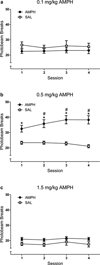High impulsivity in rats predicts amphetamine conditioned place preference
- PMID: 21807020
- PMCID: PMC3242916
- DOI: 10.1016/j.pbb.2011.07.012
High impulsivity in rats predicts amphetamine conditioned place preference
Abstract
Stimulants such as d-amphetamine (AMPH) are used commonly to treat attention-deficit hyperactivity disorder (ADHD), but concerns have been raised regarding the use of AMPH due to its reinforcing and potentially addictive properties. The current study examined if individual differences in impulsive choice predict AMPH-induced hyperactivity and conditioned place preference (CPP). Rats were first tested in delay discounting using an adjusting delay procedure to measure impulsive choice and then were subsequently tested for AMPH CPP. High impulsive (HiI) and low impulsive (LoI) rats were conditioned across four sessions with 0.1, 0.5, or 1.5 mg/kg of AMPH. AMPH increased locomotor activity for HiI and LoI rats following 0.5 mg/kg but failed to increase activity following 0.1 and 1.5 mg/kg. CPP was established for HiI rats with both 0.5 and 1.5 mg/kg of AMPH, whereas LoI rats did not develop CPP following any dose of AMPH; HiI and LoI groups differed significantly following 0.5 mg/kg of AMPH. These results indicate that HiI rats are more sensitive to the rewarding effects of AMPH compared to LoI rats, which is consistent with research showing that high impulsive individuals may be more vulnerable to stimulant abuse.
Copyright © 2011. Published by Elsevier Inc.
Conflict of interest statement
The authors report no conflict of interest
Figures



References
-
- Aguilar MA, Rodríguez-Arias M, Miñarro J. Neurobiological mechanisms of the reinstatement of drug-conditioned place preference. Brain Res Rev. 2009;59:253–277. - PubMed
-
- Ainslie G. Specious reward: A behavioral theory of impulsiveness and impulse control. Psychol Bull. 1975;82:463–496. - PubMed
-
- American Psychiatric Association. Diagnostic and statistical manual of mental disorders, 4th ed. DSM-IV. Washington: American Psychiatric Association; 1994.
-
- Baker F, Johnson MW, Bickel WK. Delay discounting in current and neverbefore cigarette smokers: Similarities and differences across commodity, sign, and magnitude. J Abnorm Psychol. 2003;112:382–392. - PubMed
Publication types
MeSH terms
Substances
Grants and funding
LinkOut - more resources
Full Text Sources

